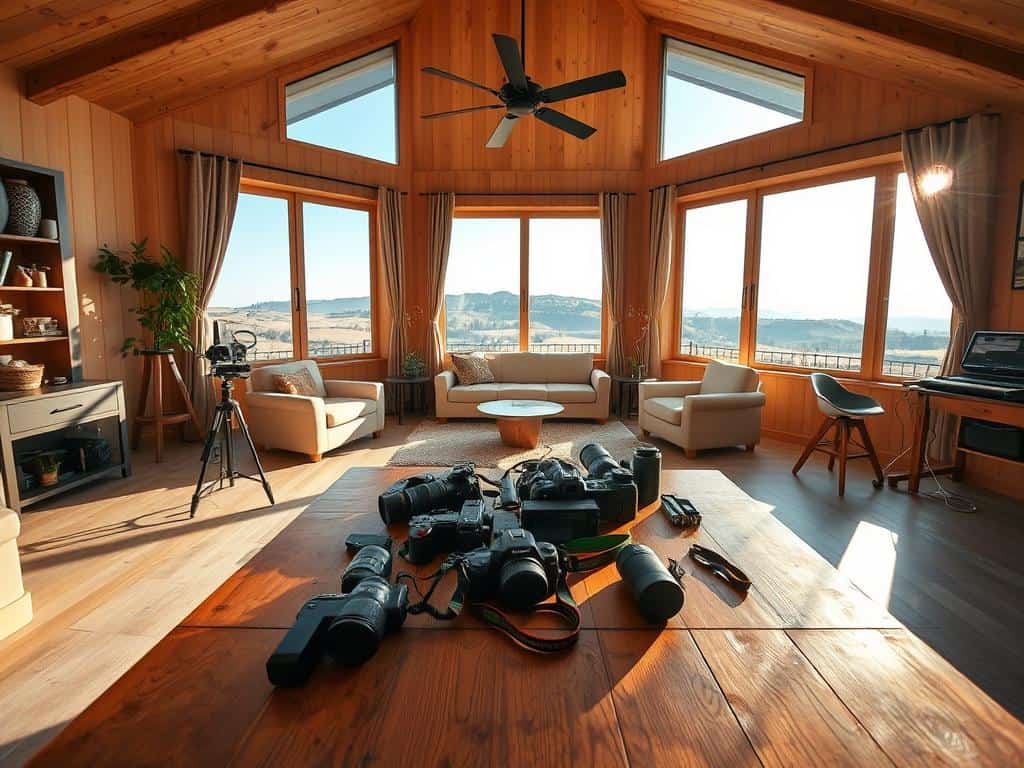Standing at the park’s edge, camera in hand, I felt both excited and scared. The world of photography stretched out like a blank canvas. Yet, I was unsure how to turn what I saw into meaningful images.
Like many, I wanted to capture the beauty around me. But photography can be overwhelming for beginners. That’s why I’ve put together this beginner photography guide. It’s filled with tips to help beginners like you.
In these pages, you’ll learn ten key photography tricks. You’ll discover how to set up your camera and improve your composition. These tips will help you take better photos and spark your creativity. Are you ready to turn your passion into art? Let’s start!

Key Takeaways
- Choose the right camera body to match your photography style and needs.
- Invest in quality lenses as they significantly enhance your photographic versatility.
- Always carry a tripod to ensure stability and prevent blurry images.
- Be prepared with extra memory cards and batteries for uninterrupted shooting.
- Familiarize yourself with the exposure triangle: ISO, shutter speed, and aperture.
- Practice composition techniques, like the rule of thirds, for captivating visuals.
Understanding the Basics of Camera Settings
Learning the basics of camera settings is key for improving your photography. The exposure triangle is at the core, made up of ISO, shutter speed, and aperture. Each setting affects how your photos turn out, changing the look based on how you adjust them.
Mastering Exposure Triangle
The exposure triangle is the base for balanced photos. Knowing how ISO, shutter speed, and aperture work together is essential. ISO controls how sensitive your camera is to light. Lower ISOs are best for bright scenes, while higher ones are for dark ones.
Changing the ISO affects the grain or noise in your photos. Learning to manage this is important.
The Importance of ISO, Shutter Speed, and Aperture
Aperture is key in photography, controlling light entry. A smaller f-number means a wider aperture and a shallower depth of field. This creates a nice blur in the background. A larger f-number means a narrower aperture, giving you more depth of field.
Shutter speed controls how long your camera’s sensor is exposed to light. Faster speeds freeze action, while slower ones create motion blur. This affects how movement is shown in your photos.
Exploring Manual Mode for Creative Control
Manual mode gives you full control over your camera. It lets you adjust aperture, shutter speed, and ISO to get the right exposure. This way, you can capture every moment with precision.
Essential Photography Tips for Beginners
As a beginner, learning key techniques can really boost your photography skills. These tips help improve your images and master your camera’s basics. Using natural light is key to taking amazing photos. The best times for this are early morning or late afternoon, when the light is soft and golden.
Utilizing Natural Light to Enhance Your Photos
Using natural light can greatly improve your photos. I find that shooting during the “golden hour” gives a soft, flattering light. This light makes colors and details pop, making your photos more vibrant and engaging.
Learning the Rule of Thirds for Better Composition
The rule of thirds is a basic but powerful technique. It involves seeing a grid that divides your image into nine parts. Place important elements on these lines or at their intersections to guide the viewer’s eye and create a dynamic photo. Many cameras have a grid option to help you use this rule.
Getting to Know Your Camera Manual for Optimal Use
Learning your camera’s manual is vital. It teaches you about all the settings and features. Moving from auto to manual modes has helped me a lot. Knowing about aperture, shutter speed, and ISO lets you control your photos better. Spending time on this will help you get the most out of your camera.
Experimenting with Photo Composition
Composition is key in photography. It helps tell the story of the photo. I find that trying new angles and views can make a big difference. It turns a simple scene into something amazing.
Creative Angles and Perspectives
When I shoot, I think about my angle. High or low shots change how we see the image. By changing my height or spot, I bring out new details.
This makes my photos more interesting. It makes people want to look closer and see more.
Foreground Interest and Depth in Imagery
Adding things in the front makes the photo feel deeper. I look for interesting things to put in the front. This helps guide the viewer’s eye.
It makes my photos more fun to look at. It’s all about creating a flow that grabs your attention.
The Value of Background Simplicity
A simple background is as important as the subject. I always check for distractions. This keeps the focus on what’s important.
By keeping it simple, I make sure the viewer stays interested. Sometimes, breaking rules leads to exciting photos.
Conclusion
Mastering photography is a journey of creativity and learning. I’ve found that using photography tips for beginners helps me grow. Learning about camera settings like ISO, shutter speed, and aperture is key.
By trying out different lighting, angles, and compositions, my art improves. This growth not only makes my photos stunning but also helps my portfolio. Investing in good gear like tripods and reflectors opens up new creative paths.
Practicing in manual mode and using the exposure triangle boosts my confidence. Visiting places like Cedar Creek gives me chances to practice and learn. This journey turns challenges into powerful stories, deepening my love for photography.
